

TEXT: Effective team communication? Focus on quality! Key points The relationship between team communication and team performance may depend on many different factors, like how much face-to-face time the team has, how familiar they are with each other, or the way that team members communicate with each other.The link between communication and performance seems to be stronger when you focus on the quality, rather than the quantity of communication.
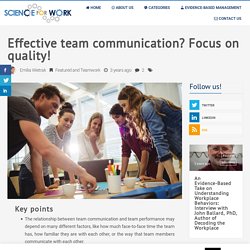
When you are seeking to improve the quality of your team’s communication, it may help if you address both the “what” – the content of the communication, and the “how” – the way your team communicates. TEXT: 10 Strategies for Schools to Improve Parent Engagement. By: Jennifer Larson Studies of successful schools indicate that a high rate of parent involvement is a major factor in their success and can even help close the achievement gap between groups of students.

Yet while 85 percent of parents feel they could personally make “a lot” or “a fair amount” of difference in their child’s learning and academic progress, 46 percent of parents wish they could do more to support their child’s education. TEXT: Communicate Important Information with ELL Families: Strategies for Success. It is critical for schools to understand the rights that English language learners (ELLs), immigrant students, and their families have regarding access to schooling and information in their home languages.
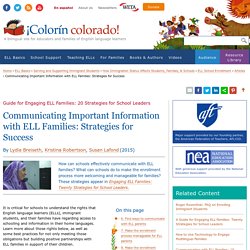
Learn more about those rights below, as well as some best practices for not only meeting those obligations but building positive partnerships with ELL families in support of their children. Supporting immigrant families For related ideas, see the following: TEXT: Six Tips for Communicating Student Progress to Parents. Mumble the words “report card” and watch teachers shudder with dread.
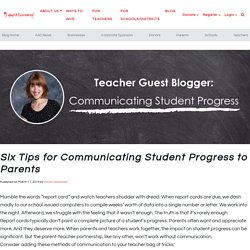
When report cards are due, we dash madly to our school-issued computers to compile weeks’ worth of data into a single number or letter. We work into the night. Afterward, we struggle with the feeling that it wasn’t enough. TEXT: Transparent Teaching, Better Learning. I sat down in a café with a nervous smile on my face.
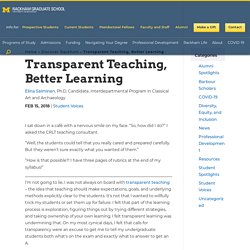
“So, how did I do?” I asked the CRLT teaching consultant. “Well, the students could tell that you really cared and prepared carefully. But they weren't sure exactly what you wanted of them.” Checking for understanding digitally during content area learning. TEXT: How Transparency Can Transform School Culture. School and district leaders can model transparency by sharing the notes from staff meetings, school board meetings and even in-service teacher learning days with the whole school community.
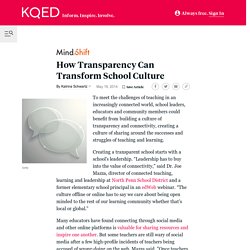
Removing the mystery can help everyone see why the district does what it does. That includes being clear with students about what the goals are and where the district is going so that they can be part of the transparent culture too. Leaders can also share what they’ve learned from conferences and bring that excitement back to the district.
“When you are using digital tools and other social media it’s like you’re yelling out the front door of your school because you are so proud of something,” Mazza said. TEXT: Four Pillars for Transformative School Leadership. How schools will reopen this fall remains in question.
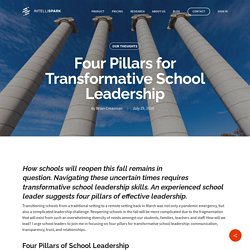
Navigating these uncertain times requires transformative school leadership skills. An experienced school leader suggests four pillars of effective leadership. Transitioning schools from a traditional setting to a remote setting back in March was not only a pandemic emergency, but also a complicated leadership challenge. Reopening schools in the fall will be more complicated due to the fragmentation that will exist from such an overwhelming diversity of needs amongst our students, families, teachers and staff. VIDEO: Teacher Clarity. VIDEO: Morning Meetings: Building Community in the Classroom. TEXT: Mythbusters: Flexible Learning in Middle School. This blog was originally published on Singapore American School’s Perspectives Blog.
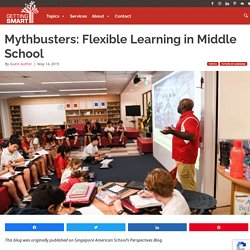
By: Lauren Mehbrach, Chris Beingessner, and Chris Raymaakers In the fall of 2016, middle school began moving towards providing more personalization for our students through the use of flexible time and space, and implementing interdisciplinary units. TEXT:12 Ways to Upgrade Your Classroom Design. TEXT: Flexible learning spaces focus on helping students be productive, comfortable. TEXT: Why Flexible Learning Environments? By: Lauren Mehrbach and Chris Beingessner.
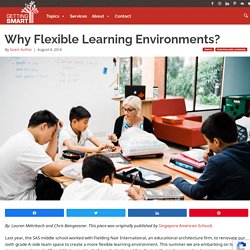
This piece was originally published by Singapore American Schools Last year, the SAS middle school worked with Fielding Nair International, an educational architecture firm, to renovate our sixth grade A-side team space to create a more flexible learning environment. TEXT: Could the Pandemic Change Education for the Better? COVID-19 has turned schooling into a universal large-scale experiment.
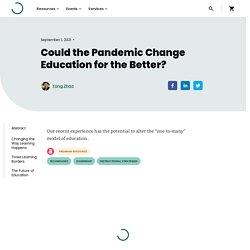
Education systems, schools, and classrooms have had to stop many old practices and invent new ones. These changes were difficult and undertaken in a period of social crisis. However, as we return to school this fall, it would be a great mistake to slip back into pre-pandemic ways of functioning. Perhaps some of what we stopped, like state standardized testing in some cases (Gwertz, 2020), should not be returned to and some of what we built or ramped up, like certain aspects of remote learning, should continue.
VIDEO: Introducing Khan Lab School! VIDEO: Flexible Classrooms: Providing the Learning Environment That Kids Need. VIDEO: How to Teach Students to Manage Their Own Conflicts. VIDEO: The 7 Keys to Creative Collaboration. VIDEO: Individualized Learning for preschoolers. TEXT: How do I develop student ownership and accountability in a station rotation model? Student Data: Empower students to own their learning In order to allow students to continually grow, they need constant feedback and reflection. Though it may be a teacher’s instinct to interpret student performance data and give students direct feedback, shifting part of the data analysis and reflection to students empowers them to understand their ongoing progress, constantly reflect, and try new strategies to improve.
As with any other skill, students need guidance and support in... Interpreting their data.Making conclusions.Identifying next steps. TEXT: Goal Setting for Students Is Easier Than You Think. As a teacher, you regularly think about goal setting for students. From improving skills and meeting standards to being kind and putting the darn caps back on the glue sticks, there’s always something to strive towards. Have you tapped into the power of setting goals with students, though?
TEXT: Goal Setting for Students, Kids, & Teens (Incl. Worksheets & Templates) Do you remember when you learned how to set goals? If you have trouble answering that question, you’re not alone! Most of us don’t spend much time thinking about how we set goals. In fact, many of us don’t even think of goal setting as a skill; rather, it’s just something we do without reflecting on it much.
However, goal setting is a practice that operates on a set of specific skills—and luckily, these skills are relatively easy to teach. TEXT: Continuously Refine Your Practice With Student Feedback. A few weeks into each semester, Gayle Golden asks her University of Minnesota journalism students to answer a few brief, anonymous questions about the course she teaches. After examining responses, she discusses the results with her students during the next class.
“She tells them which suggestions she plans to put into practice, which recommendations she can’t act on, and why,” writes Rebecca Koenig for EdSurge. TEXT: Seven Keys to Effective Feedback. Who would dispute the idea that feedback is a good thing? Both common sense and research make it clear: Formative assessment, consisting of lots of feedback and opportunities to use that feedback, enhances performance and achievement. Yet even John Hattie (2008), whose decades of research revealed that feedback was among the most powerful influences on achievement, acknowledges that he has "struggled to understand the concept" (p. 173). And many writings on the subject don't even attempt to define the term. To improve formative assessment practices among both teachers and assessment designers, we need to look more closely at just what feedback is—and isn't. TEXT: A Classroom Full of Risk Takers.
TEXT: Moving from Feedback to Feedforward. VIDEO: Creative, Flexible Mathematics with Jo Boaler. VIDEO: Daring Classrooms with Brené Brown. TEXT: A culturally responsive framework for enhancing phonological awareness development in children with speech and language impairment.